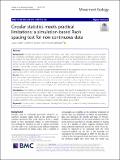Files in this item
Circular statistics meets practical limitations : a simulation-based Rao’s spacing test for non-continuous data
Item metadata
| dc.contributor.author | Landler, Lukas | |
| dc.contributor.author | Ruxton, Graeme D. | |
| dc.contributor.author | Malkemper, E. Pascal | |
| dc.date.accessioned | 2019-05-14T15:30:02Z | |
| dc.date.available | 2019-05-14T15:30:02Z | |
| dc.date.issued | 2019-05-10 | |
| dc.identifier | 258950688 | |
| dc.identifier | 42bffe8e-4619-4cf3-acea-8069ecd22415 | |
| dc.identifier | 85065608204 | |
| dc.identifier | 000467658800001 | |
| dc.identifier.citation | Landler , L , Ruxton , G D & Malkemper , E P 2019 , ' Circular statistics meets practical limitations : a simulation-based Rao’s spacing test for non-continuous data ' , Movement Ecology , vol. 7 , 15 . https://doi.org/10.1186/s40462-019-0160-x | en |
| dc.identifier.issn | 2051-3933 | |
| dc.identifier.other | RIS: urn:1251A519E9CEA6B291DFBD780E8A8DE2 | |
| dc.identifier.other | RIS: Landler2019 | |
| dc.identifier.other | ORCID: /0000-0001-8943-6609/work/60427507 | |
| dc.identifier.uri | https://hdl.handle.net/10023/17703 | |
| dc.description.abstract | Background: For data collected on a circular rather than linear scale, a very common procedure is to test whether the underlying distribution appears to deviate from circular uniformity. Rao’s spacing test is often used to evaluate the support the data offers for the null hypothesis of uniformity. Here we demonstrate that the traditional version of this test fails to adequately control type I error rate when the data is non-continuous (i.e. is rounded/grouped to a finite number of discrete values, e.g. to the nearest degree, a common situation). To overcome this issue, we provide a numerically-intensive simulation version of the test. Methods: We use a simulation study to explore the performance of the traditional and our novel variant on Rao’s spacing test, both in terms of control of type I error rate and statistical power. Results: When data is measured on a continuous circular scale then both methods offer good control of type I error and similar statistical power. If the data is rounded (even to a relatively fine scale such as to the nearest degree – giving 360 possible values), however, the traditional method produces highly inflated type I error rates, particularly with high sample sizes, that make it inappropriate for application to such data. In contrast, our simulation method retains good control of type I error while offering levels of statistical power similar to the traditional Rao test. Conclusions: The traditional method of applying Rao’s spacing test should be replaced by the simulation-based variant introduced here. The two methods offer similar performance but only the simulation method retains good control of the type I error rate when circular data is rounded to a finite set of values (likely due to limited precision of measuring equipment). Adoption of the simulation variant will substantially improve the reliability of this regularly-used test in the commonplace situation where data values are rounded. | |
| dc.format.extent | 5 | |
| dc.format.extent | 732856 | |
| dc.language.iso | eng | |
| dc.relation.ispartof | Movement Ecology | en |
| dc.subject | Circular statistics | en |
| dc.subject | Limited precision | en |
| dc.subject | Rayleigh test | en |
| dc.subject | Testing for circular uniformity | en |
| dc.subject | Randomisation testing | en |
| dc.subject | Statistical power | en |
| dc.subject | Oriana | en |
| dc.subject | QH301 Biology | en |
| dc.subject | QA Mathematics | en |
| dc.subject | DAS | en |
| dc.subject.lcc | QH301 | en |
| dc.subject.lcc | QA | en |
| dc.title | Circular statistics meets practical limitations : a simulation-based Rao’s spacing test for non-continuous data | en |
| dc.type | Journal article | en |
| dc.contributor.institution | University of St Andrews. School of Biology | en |
| dc.contributor.institution | University of St Andrews. Centre for Biological Diversity | en |
| dc.identifier.doi | https://doi.org/10.1186/s40462-019-0160-x | |
| dc.description.status | Peer reviewed | en |
This item appears in the following Collection(s)
Items in the St Andrews Research Repository are protected by copyright, with all rights reserved, unless otherwise indicated.

